Pamela Phatsimo Sunstrum It Will End in Tears
The Curve, Barbican Centre
17 September - 5 January05-12-2024
What does it mean to be cast as a juror in a trial that has already taken place, whose verdict has already been delivered? In Pamela Phatsimo Sunstrum’s first UK solo exhibition, the title spoils the ending. It will end in tears: a statement of rigid finality.
“It Will End in Tears” unfolds in fragments. In the Barbican’s The Curve gallery, Sunstrum, who is based in The Hague, presents a series of film noir vignettes rendered large-scale in oil and pencil on wood. Each work — titled non-sequentially as, for example, Scene 7 or Scene 58 — comprises a grid of panels that never entirely connect, like photographs ripped apart in a moment of melodrama and stitched back together in fugitive remorse. The narrative follows a loose three-act structure, reminiscent of Hitchcock’s Rear Window, which was screened by Sunstrum as part of the exhibition’s programing and echoes in the exhibition’s ubiquitous windows, obstacles and thresholds. The first act depicts moments of orientation and processing, as Bettina — Sunstrum’s protagonist and lookalike — arrives at a colonial outpost in Botswana, the surrogate authority of a far-away government. In the second act, the scenes shift to a domestic space simmering with tension, leading to a moment of violence that anchors the final act: a courtroom drama surrounding a murder trial.
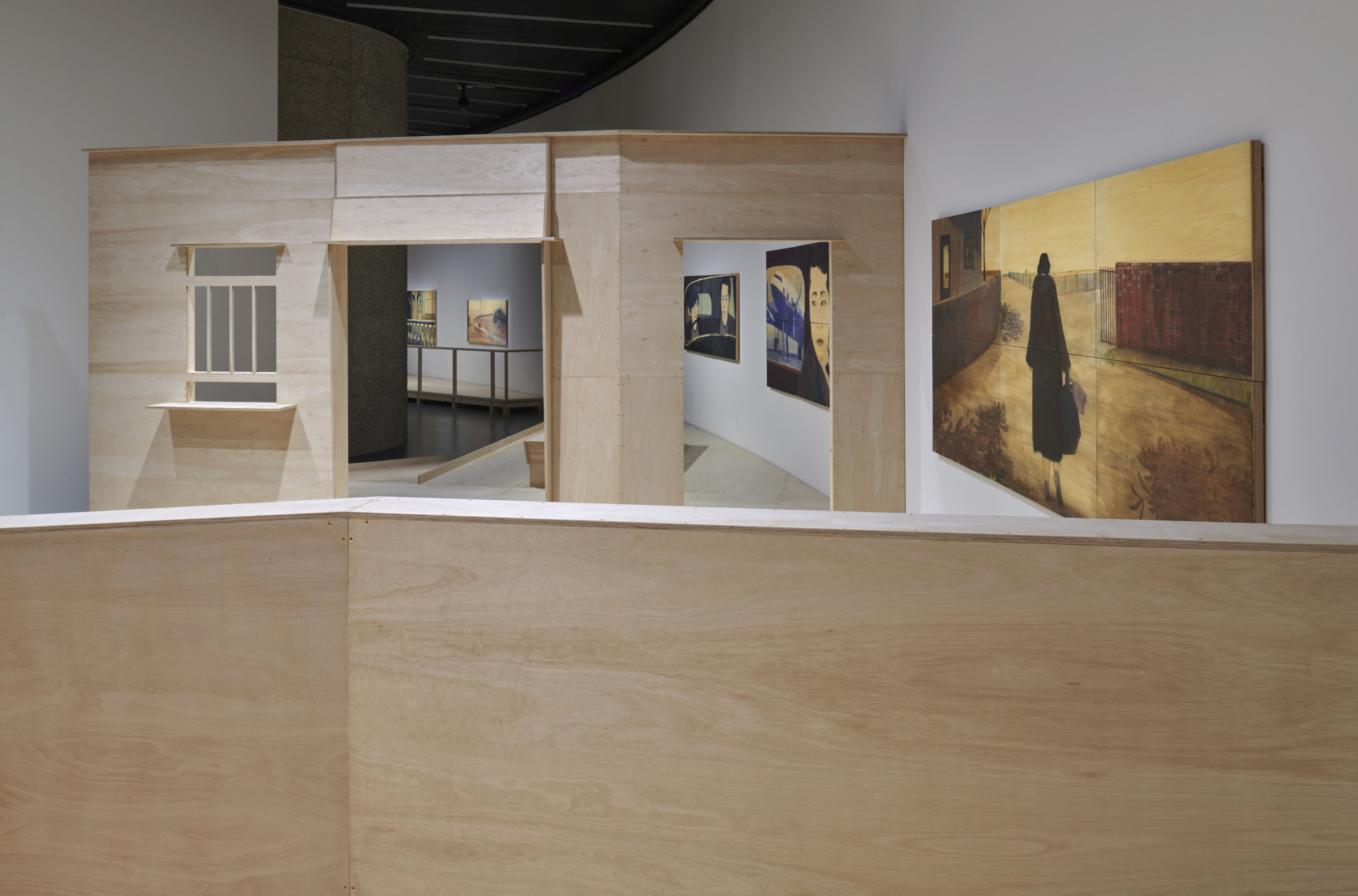
Each of the acts is animated by a series of faux film sets created by the artist Remco Osório Lobato and organized as a kind of scaffolding upon which Sunstrum’s evidence is mounted. These sets often use partial or minimal structural elements to suggest provisional or floating spaces — verandas, checkpoints — not entirely anchored in reality. Truth is literally fabricated through these fragile, temporary stages; a world poised between verifiability and deception, where the boundaries of reality are splintered and porous. The viewer’s position within the scene is deliberately ambiguous and seems to oscillate between different roles often in tension with one another: spectator and voyeur, who witnesses moments of private conflict or tender affection; participant and actor, such as the bystanders to a crime in Scene 45 or the private investigator in Scene 58; or juror and colonial bureaucrat, ever more complicit in the administrative and institutional mechanisms that control the characters’ fates with every step. Barriers appear in each painting too, from the outpost’s fencing in Scene 7 to the marble balustrades in Scene 10. These multiple positions, and the many thresholds we must cross, alert us to the dominance of control and containment within the narrative all pointing to an unseen, unspoken and possibly unspeakable violence. Every scene, like a film still captured before “Action!”, seems suspended in a moment of unrealizable potential, held hostage by the quiet threat of its own actualization. It feels as though the viewer’s incursion—somewhere between innocence and complicity, restriction and invitation—may in fact pull the trigger.
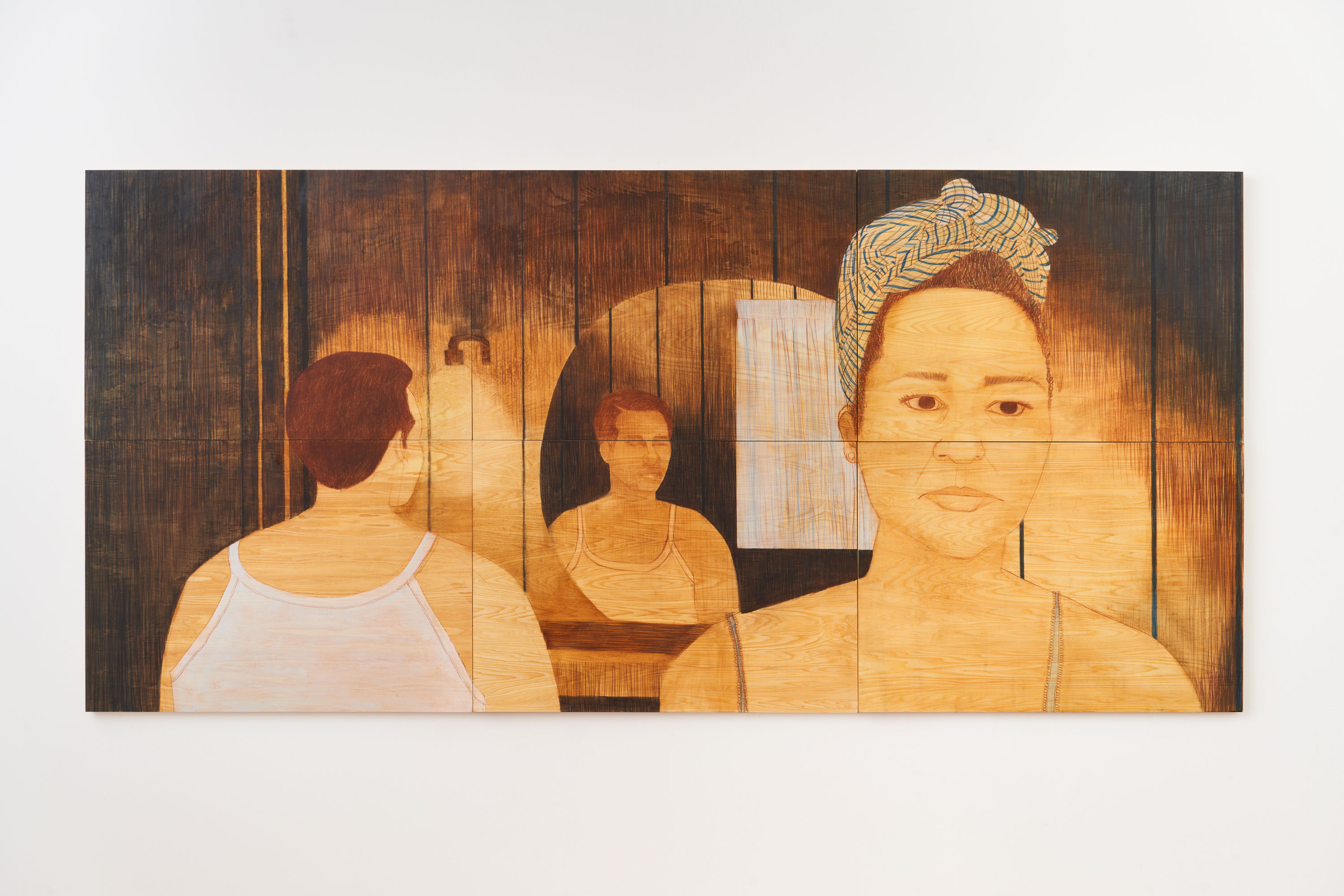
The Barbican itself is implicated by Sunstrum, too, but perhaps not sufficiently, in what seems like a missed opportunity. Occupying the site of Roman London’s main fort, the modern-day complex echoes the ancient barbican—an outpost or walled city — with towering apartments, like sentinels, laid out in an impenetrable pattern of moats and jetties, its residents visible yet unreachable. Upon discovering the architectural purpose of The Curve — a sound barrier to buffer the neighboring concert hall — Sunstrum “became fascinated by this liminal zone: a space that encases not only the spectacle, but also the secrets of [its] tricks and devices.” While liminality is conspicuous within the painted scenes themselves, the linearity and unmistakable start and endpoints of the painted narrative, within the gallery’s broken circle, impairs a more structural, perhaps more pervasive representation of stasis. Bettina’s arrival at the outpost marks a clear start, and the court trial anchors its conclusion, communicating a legal framework of finality, in which disputes must eventually reach a resolution. Nothing can remain suspended forever, it will end.
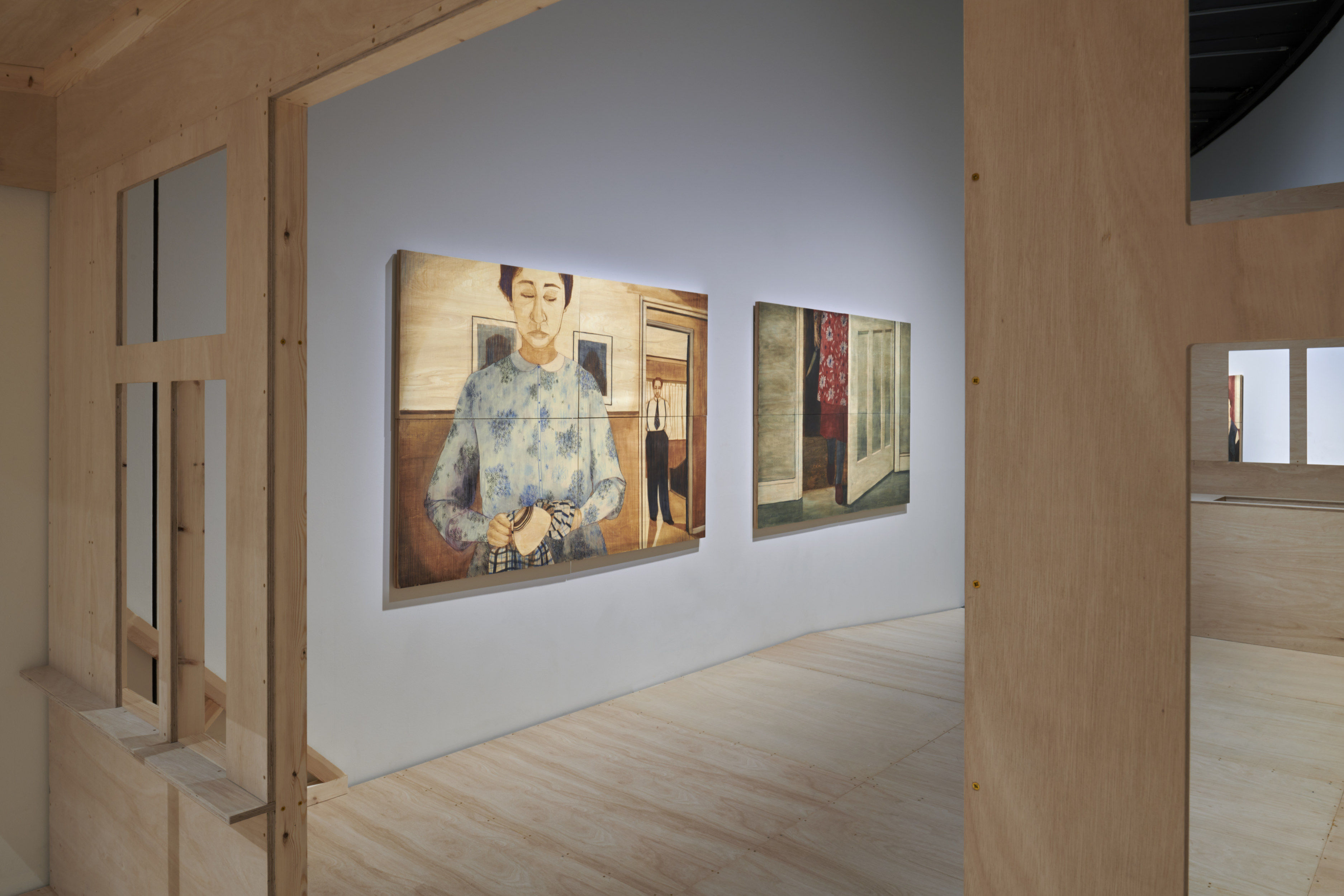
Although there are digressions and blanks in the narrative, its arc is as unyielding as the curved gallery walls that propel one scene breathlessly into the next. Perhaps the storytelling could be more imperfect, more fractured and so more self-reflexive, consciously undermining the femme fatale trope and the co-opted noir aesthetic by drawing attention to its own fallibility. Would it be more effective perhaps to further confuse the order of the fragments, to scatter the vignettes? And what if one panel were removed from each painting, or exchanged for a panel in another? A dialogue might become a monologue; a departure turns into an arrival. Yet, the dominant narrative's assured linearity is vital so that Sunstrum can construct an intentionally unassured, wobbly and ambiguous counter-narrative. Working backwards with this in mind, the paintings — whittled down from 60 storyboard drawings made by Sunstrum — become discernible through another lens: an unreliable deposition presented to a biased jury. The characters’ emotions are betrayed not by the pastiche noir of their expressions, but in the knots and undulations of the wood’s grain below. Sunstrum’s narrative, like The Curve’s function, is a kind of stifling, a suppression. She astutely noted that “even squeezed between two barriers, history still persists.” Perhaps, like a noise emanating from two pursed lips, history is intensified by its suppression. History persists, cruel, relentless and imminent, as steadily assured as the black saloon in Scene 7, traversing the barren horizon midway through this cautionary tale which, in turn, foreshadows the convoy of police cars slicing through the driving rain in pursuit of their presumed culprit at its climax. Pain awaits — in fact it already throbs.
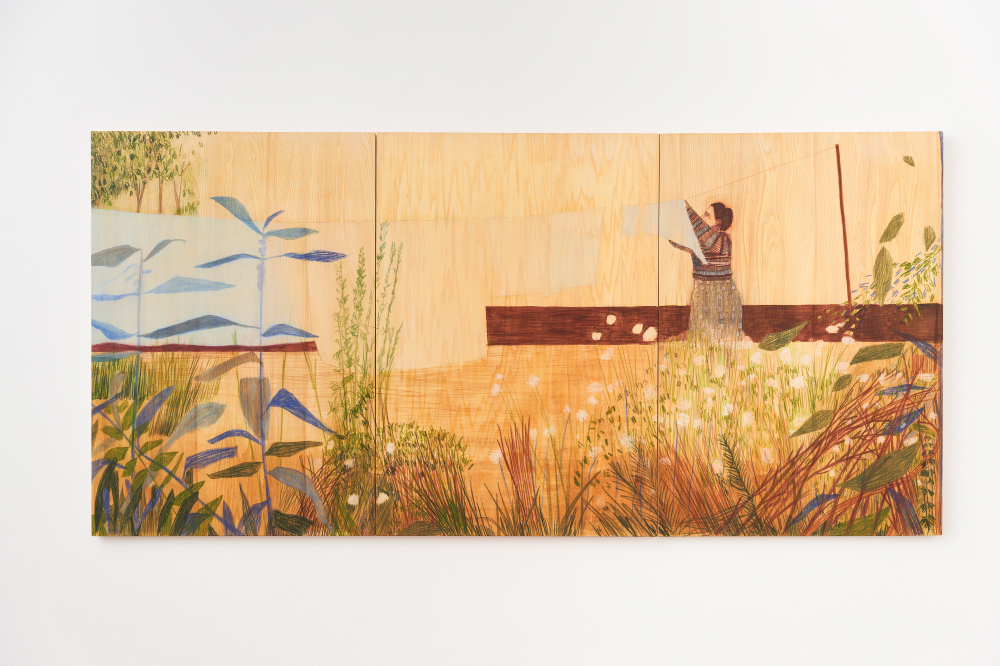
Recounting his move from Jamaica to Britain in the early 1950s — the former, at that moment, poised to move towards self-government and independence — Stuart Hall described his life as “sharply divided into two unequal, entangled halves. You could say I have lived…on the hinge.”¹ Hall reflects on his childhood experiences amidst anti-colonial tumult as a “slow disentangling of threads, a process of disenchantment and disaffiliation […] an unpleasant experience, replete with gaps, contradictions, evasive silences, guilt and rage.” The hinge seems an apt signifier for “It Will End in Tears”. In its second act, opening inside a home built in Osório Lobato’s material shorthand, sparse “ghost props” blend into the wood: a drained sink and unused writing bureau offer hollowed-out symbols of domesticity, items one might jettison when moving house. Gazing through the kitchen window above the sink, one encounters Sunstrum’s most vivid painting, Scene 19, where, spied through a foreground of verdant, tangled foliage, a woman hangs washing on a line. In Scene 10, directly to the left, a man with cap in hand approaches a woman at a busy dinner party with a romantic proposition. To see both works more closely, one must step off the wooden flotilla into an anxious interspace, a portal—perhaps the “gap” that Hall described — as if no longer atop a raft but floating beneath it. Like Sunstrum’s paintings, Osório Lobato’s dioramas are not always seamless, producing ruptures in these absences and, ironically, powerful moments when their supports momentarily disappear. This feeling of untethered-ness between the installation adds another layer of fiction. Scene 19 and Scene 10, taken as a diptych, signifies an unquenchable desire: the idyll of domesticity within an Edenic garden — perhaps the false utopia of return to an imagined homeland — and the flickering ache of unfulfilled romance. The “slow disentangling of threads”.
Eventually, The Curve becomes a pipeline in which everything — the flotilla, the jettisoned objects — is pulled towards a familiar denouement. The viewer is processed once again and enters the towering courtroom of the final set. Two paintings display an all-white jury presiding over the case and a sinking feeling swells. What does it mean to be cast as a juror in a trial that has already taken place, whose verdict has already been delivered? Maybe fittingly, but disappointingly nonetheless, the exhibition struggles to extricate itself from the tropes it references. But this disappointment and inevitability almost becomes its praxis. “A choice of pains. That's what living was all about,” wrote Audre Lorde, when reflecting upon her abortion in Zami: A New Spelling Of My Name.² There’s disappointment in knowing that the path is set, deviation impossible. Disappointment in womanhood, in how choices, constrained by circumstance, often lead to preordained endpoints. Sunstrum presents a final painting as an epilogue: an arched bridge carries two figures towards one another over waters that flow along the wood’s grain. It seems to offer resolution yet, like the mirror as a noir motif of deceit, the bridge’s reflection in the water below reveals its own quiet fallacy.
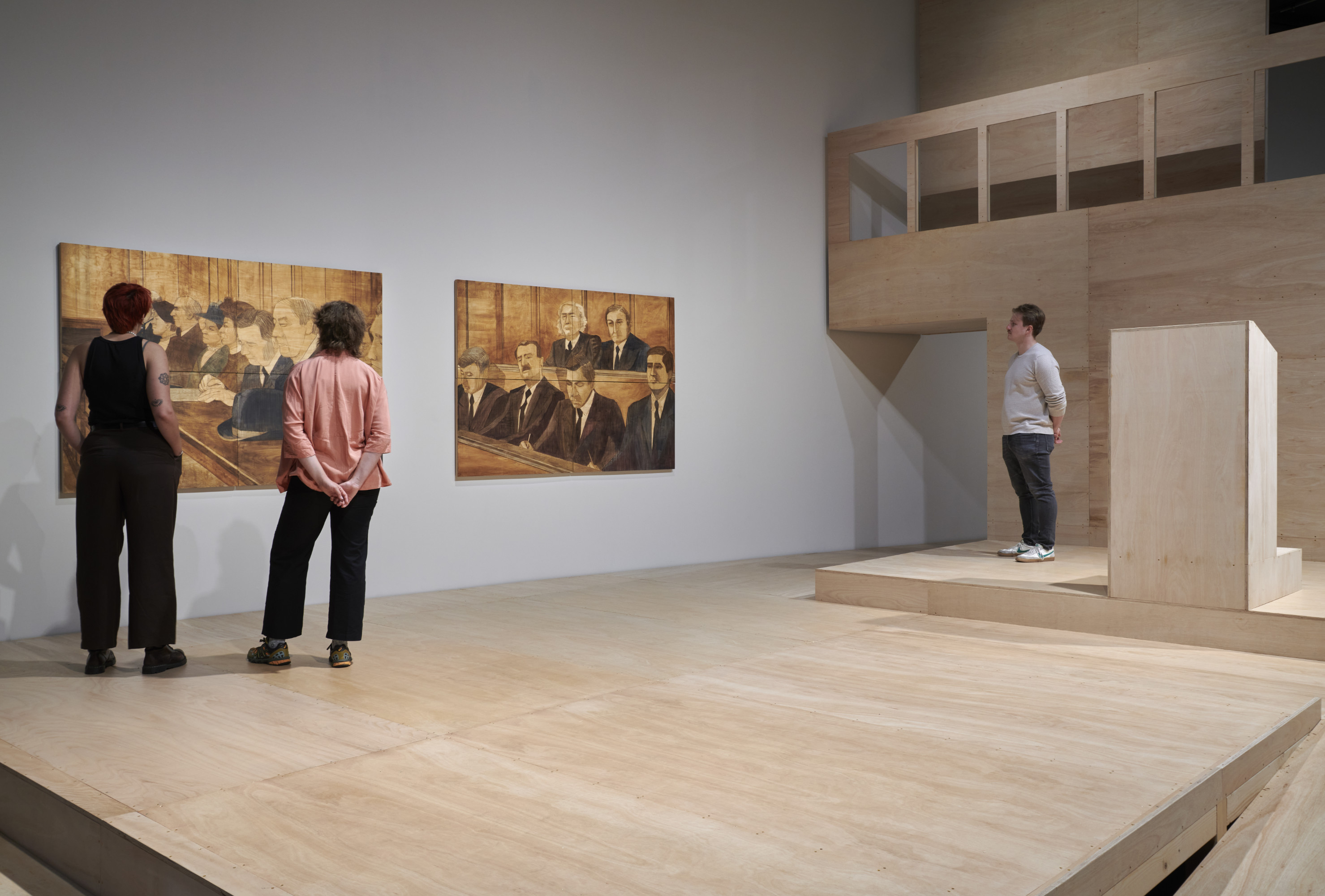
- Stuart Hall, Familiar Stranger: Life Between Two Islands, Durham, N.C.: Duke University Press, 2018, 11.
- Audre Lorde, Zami: A New Spelling of My Name, Watertown, M.A.: Persephone Press, 1982, 111.